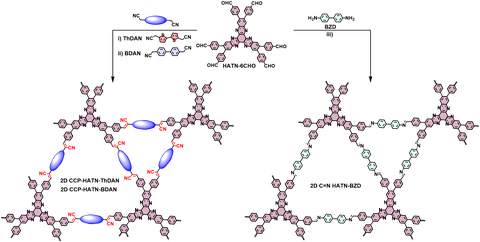Nov 20, 2020
Thiophene‐Bridged Donor–Acceptor sp2-Carbon-Linked 2D Conjugated Polymers as Photocathodes for Water Reduction
Figure 1: Scheme for the synthesis of 2D CCP‐HATN-ThDAN and 2D CCP‐HATN-BDAN (left) and imine‐linked 2D C=N HATN-BZD (right) from HATN‐6CHO. Reaction conditions: i) for 2D CCP‐HATN-ThDAN: NEt4OH (0.1 M), dimethylacetamide (DMAc)/ortho‐dichlorobenzene (o‐DCB) = 3/7, 150 °C, 3 days; ii) for 2D CCP‐HATN-BDAN: Cs2CO3 (0.1 M), DMAc/o‐DCB = 1:1, 120 °C, 3 days; iii) for 2D C=N HATN-BZD: DMAc/mesitylene (Mes)/acetic acid (HOAc, 6 m) = 5/5/1, 120 °C, 3 days.
Photoelectrochemical (PEC) water reduction, converting solar energy into environmentally friendly hydrogen fuel, requires delicate design and synthesis of semiconductors with appropriate bandgaps, suitable energy levels of the frontier orbitals, and high intrinsic charge mobility. Two-dimensional covalent organic frameworks (2D COFs), which belong to the class of 2D conjugated polymers, have recently emerged as a promising class of materials for photocatalysis and PEC applications due to the tailored energy bandgaps, positions of the frontier orbitals, and active centers. However, traditional imine‐linked 2D COFs generally exhibit moderate electron delocalization and poor chemical stability, which hamper the potential implementation of these materials in PEC applications.
In this respect, a group of scientists from Technische Universität Dresden (TUD, Chair for Molecular Functional Materials) and collaborators have developed a novel bithiophene-bridged donor-acceptor-based two-dimensional sp2-carbon-linked conjugated polymer (2D CCP). The Knoevenagel polymerization between the electron‐accepting building block 2,3,8,9,14,15‐hexa(4‐formylphenyl) diquinoxalino[2,3‐a:2′,3′‐c]phenazine (HATN‐6CHO) and the first electron‐donating linker 2,2′‐([2,2′‐bithiophene]‐5,5′‐diyl)diacetonitrile (ThDAN) provided the donor-acceptor containing 2D CCP‐HATN-ThDAN with a dual pore structure and high stability. Benefitting from the sp2-carbon-linked framework and donor-acceptor structure, the 2D CCP-HATN-ThDAN exhibited a wide light harvesting range (up to 674 nm), a narrow optical energy gap (2.04 eV), and separated HOMO-LUMO distributions for facilitated charge transfer. When employed as photocathode for PEC water reduction, 2D CCP-HATN-ThDAN presents a superb H2-evolution photocurrent density up to ~7.9 µA cm‑2 at 0 V vs. reversible hydrogen electrode (RHE).
Reference: Shunqi Xu, Hanjun Sun, Matthew Addicoat, Bishnu P. Biswal, Fan He, SangWook Park, Silvia Paasch, Tao Zhang, Wenbo Sheng, Eike Brunner, Yang Hou, Marcus Richter, Xinliang Feng*, “Thiophene‐Bridged Donor–Acceptor sp2‐Carbon‐Linked 2D Conjugated Polymers as Photocathodes for Water Reduction”, Adv. Mater. 2020, 2006274. Link: https://onlinelibrary.wiley.com/doi/full/10.1002/adma.202006274
Acknowledgments: This work was supported financially by the DFG for the CRC 1415 (No. 417590517), the ERC Consolidator Grant (T2DCP, No. 819698), Coordination Networks: Building Blocks for Functional Systems (SPP 1928, COORNET), EU Graphene Flagship (GrapheneCore3; No. 881603), H2020‐MSCA‐ITN (ULTIMATE, No. 813036), and Center of Advancing Electronics Dresden (cfaed).

